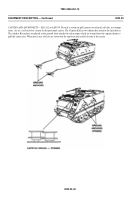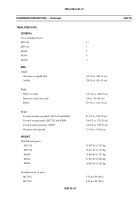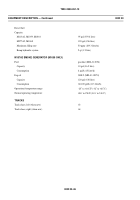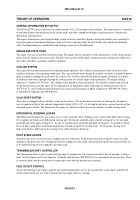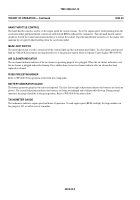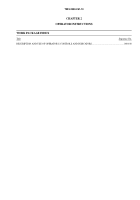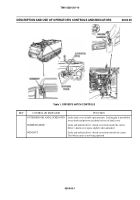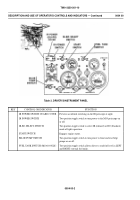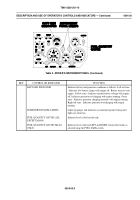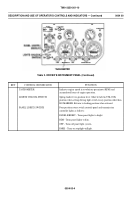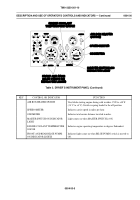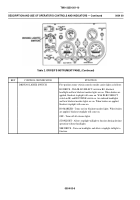TM-9-2350-261-10 - Page 97 of 761
TM 9-2350-261-10
THEORY OF OPERATION
0003 00
GENERAL INFORMATION M113A2 FOV
The M113A2 FOV carrier is powered by a liquid cooled 6V53, 210 horsepower diesel engine. The engine power is converted
to mechanical power and transferred to the carrier tracks and other components through a transfer gearcase, transmission,
differential, and final drives.
The engine, transmission, and steering/braking system are driver controlled. Engine startup and shutdown are controlled by
electrical signals and mechanical linkages connected to the accelerator pedal, the fuel shutoff cable, and the hand throttle
cable. Steering/braking are controlled through linkages connected to the differential.
ENGINE AND DRIVE TRAIN
The engine converts air and diesel fuel into energy. The engine delivers this power to the transmission. A drive train transfers
power from the engine to the carrier track. The drive train consists of the engine, transfer gearcase, transmission, differential,
drive lines, final drive assemblies, and drive sprockets.
COOLING SYSTEM
The engine and transmission generate heat during normal operation. The cooling system transfers some of the heat to the
outside to maintain a safe operating temperature. The vent fan draws air in through the radiator, circulates it around the power
plant, and expels it through the grill above the vent fan. The vent fan is belt-driven from the engine crankshaft. A mixture
of antifreeze and water is pumped through the cooling system to cool the engine and transmission. The engine cooling
capacity is 9.5 gallons (35.96 liters). The cooling system should be checked regularly. The auxiliary radiator tank, located
on the traverse beam, provides space for the separation of air and liquid coolant. Stop engine if temperature goes above
200 F (93.3 C). See Cooling System illustration in Location and Description of Major Components (WP 0002 00). Refer
to Check/Fill Cooling System (WP 0088 00).
COLD START SYSTEM
The engine is equipped with a cold start system (air box heater). The air box heater heats the air entering the cylinders to
assist in ignition of fuel at low ambient temperatures (below 40F(4.4 C)). A fuel and air mixture is sprayed into the air box
and spark ignites a flame. The flame heats the engine air, which is fed directly into the cylinders to make starting easier.
DIFFERENTIAL STEERING LEVERS
The differential steering levers are used to steer as well as stop the carrier. Pulling on one or both of the differential steering
levers applies the brakes in the differential steering unit. To turnleft
,graduallypullontheleftsteeringlever
.Toturnright,
gradually pull on the right steering lever. To slow or stop the carrier, gradually pull both steering leers. To lock the steering
levers in place, push down on the brake lock buttons, located on top of the steering levers. To release the steering levers
brake-lock buttons, pull back on the steering levers and the buttons will pop up.
PIVOT STEER LEVERS
The pivot steer levers are used to turn a stopped carrier in a tight turn. To pivot steer the carrier, bring the carrier to a stop
and pull on the pivot steer lever. Pulling the pivot lever applies the disc brake, which will lock up the one track and allow all
of the differential power to be applied to the other track.
TRANSMISSION SHIFT CONTROLLER
The transmission shifter is used to select driving range of transmission. The transmission shifter has six positions to choose
from. See Description and Use of Operator’s Controls and Indicators (WP 0004 00), for a description of each position. There
is a neutral safety switch to make sure the engine only starts with the transmission in neutral.
FUEL CUTOFF CONTROL
To start fuel flowing to the engine, push the fuel cutoff control all the way in. To stop fuel flow to the engine, pull the fuel
cutoff control all the way out. This will shut down the engine when it is running.
000300-1
º
º
º
º
Back to Top




